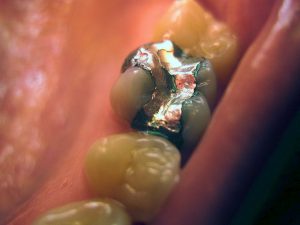 Even as a child, we all learned that playing with the little bead of mercury in science class was not a good thing. It was cool to watch it bead around, but we were warned about it toxic dangers. Of course, as we started to get older, we also found out that the dental health industry actually used mercury to fix our teeth. Really?! What was that all about?
Even as a child, we all learned that playing with the little bead of mercury in science class was not a good thing. It was cool to watch it bead around, but we were warned about it toxic dangers. Of course, as we started to get older, we also found out that the dental health industry actually used mercury to fix our teeth. Really?! What was that all about?
It has been known for years that mercury in the human body is extremely toxic and yet that is exactly what has been the filling of choice for the dental profession in filling our slightly decayed teeth. It seemed to work well over the last 100 years or so. Mainly, because when used in the mercury filling compound, it was hard and durable and easy to put in place!
It was called Dental Amalgam and is a mixture of mercury, tin, silver and other materials. However, it is mostly mercury. The potential for mercury poisoning in the human body was minimal for those with less than 3 cavities. However, as the number of cavities that was filled increased to over eight, the potential for mercury poison in the body was significant. This is partly because of the other sources where we may pick up mercury such as in certain types of fish.
A study by the University of Georgia’s College of Public Health[i] performed a study that included about 15,000 participants. This was a significant study that showed the relationship in the human population between mercury fillings and mercury poisoning in the body. It seemed to be somewhat conclusive that having more than eight mercury fillings in one’s mouth posed a significant health risk to the patient.
So the issue here is not so much the use of mercury fillings, but the quantity coupled with the other sources in life that mercury can find its way into the human body. An earlier article in 2010 from an article entitled Do fillings cause mercury poisoning?[ii] Seemed to conclude something very different!
This article is very extensive and has the conclusion that there is not any clinical evidence that mercury in the mouth due to Dental Amalgam has contributed to mercury poisoning. So now we have some recent research that seems to contradict this finding and at the same time agree with it.
The latest study conducted here somewhat agreed except when the number of fillings was eight or more. So between these two articles, maybe we can come to a very basic understanding of the subject. It is not the use of the mercury fillings that is the problem but maybe the overuse of it that may be the problem.
The technology for dental fillings has improved with the use of mercury-free resins for the filling of cavities. However, even these can create other problems such as releasing bisphenol A, or BPA in small quantities. This can have potential other health problems. So there is no really good solution here except for good dental hygiene in the first place.
The other thing to consider is that Alzheimer’s and Parkinson patients have been known to have higher amounts of mercury in their system, affecting their brains. Can this be contributed to Dental Amalgam mercury fillings? It is not completely conclusive.
As with any research, it sometimes depends on the bias of the research, the purpose of the research in the use of grants, and the personal opinions of those trying to come up with a predisposed conclusion. So what can we say from all of this?
Here is a summary.
- Mercury is toxic to the human body if absorbed in large enough quantities
- Mercury is found in sources other than Dental Amalgam fillings
- Mercury is more easily absorbed by inhalation than physical contact
- Mercury fillings become a problem when the quantity of fillings in the mouth comes close to eight or more.
- There are other replacements for Dental Amalgam mercury fillings that you can discuss with your dentist
- Good dental hygiene in the prevention of tooth decay will help prevent the need for the use of fillings in the first place.
So as with any study, observe it, apply it to your life and take the necessary precautions as a result. To your dental health, we wish you the best.
Save
Save










Leave a Reply